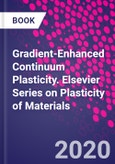Gradient-Enhanced Continuum Plasticity provides an expansive review of gradient-enhanced continuum plasticity from the initial stage to current research trends in experimental, theoretical, computational and numerical investigations. Starting with an overview of continuum mechanics and classical plasticity, the book then delves into concise lessons covering basic principles and applications, such as outlining the use of the finite element method to solve problems with size effects, mesh sensitivity and high velocity impact loading. All major theories are explored, providing readers with a guide to understanding the various concepts of and differences between an array of gradient-enhanced continuum plasticity models.
Please Note: This is an On Demand product, delivery may take up to 11 working days after payment has been received.
Table of Contents
1. Review of Theoretical Developments on Gradient-Enhanced Continuum Plasticity2. Review of Experimental Observations Gradient-Enhanced Continuum Plasticity3. Review of Numerical Simulations on Gradient Enhanced Continuum Plasticity4. Coupled Thermo-Mechanical Theory for Small Deformation5. Coupled Thermo-Mechanical Theory for Finite Deformation6. Physically-Based Gradient-Enhanced Continuum Plasticity7. Numerical Solutions8. Open Issues9. High Resolution TechniquesAuthors
George Z. Voyiadjis Boyd Professor, Department of Civil and Environmental Engineering, Louisiana State University, USA. Boyd Professor at the Louisiana State University, in the Department of Civil and Environmental Engineering. Voyiadjis is a Foreign Member of the Academia Europaea, the European Academy of Sciences, and the European Academy of Sciences and Arts. He is a Foreign Member of both the Polish Academy of Sciences, and the National Academy of Engineering of Korea. He is the recipient of the 2008 Nathan M. Newmark Medal of the American Society of Civil Engineers He is a Distinguished Member of the American Society of Civil Engineers; Fellow of the American Society of Mechanical Engineers, the Society of Engineering Science, the American Academy of Mechanics, and the Engineering Mechanics Institute of ASCE; and Associate Fellow of the American Institute of Aeronautics and Astronautics. Voyiadjis' primary research interest is in plasticity and damage mechanics of metals, metal matrix composites, polymers, and ceramics with emphasis on the theoretical modeling, numerical simulation of material behavior, and experimental correlation. Research activities of particular interest encompass macro-mechanical and micro-mechanical constitutive modeling, experimental procedures for quantification of crack densities, inelastic behavior, thermal effects, interfaces, damage, failure, fracture, impact, and numerical modeling.He has 2 patents, over 364 refereed journal articles, and 23 books (12 as editor) to his credit. He has given over 420 presentations as plenary, keynote, and invited speaker as well as other talks. Over 68 graduate students (39 Ph.D.) completed their degrees under his direction. Yooseob Song Assistant Professor, Civil Engineering Department, The University of Texas Rio Grande Valley, Texas, USA. Dr. Yooseob Song is an assistant professor in the Department of Civil Engineering at the University of Texas Rio Grande Valley. His primary research interest is in computational solid mechanics, multiscale modeling, grain boundary modeling, dynamic strain aging in metals and metal alloys, nonlocal continuum and crystal plasticity, temperature and rate dependent constitutive modeling, etc. Research activities of particular interest include macro-mechanical and micro-mechanical constitutive modeling, modeling at different length scales including finite element method for strain gradient continuum plasticity and strain gradient crystal plasticity.








